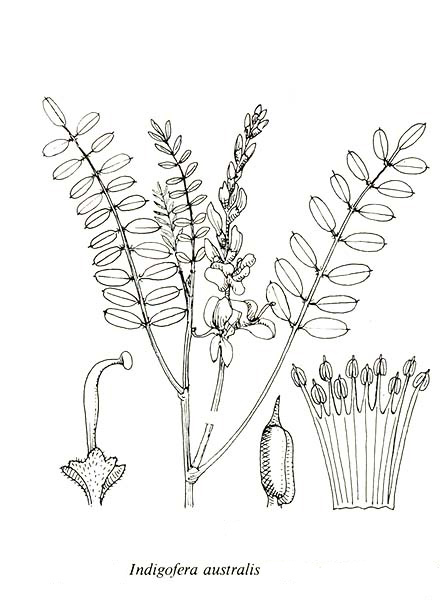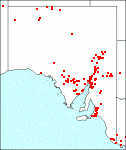Family: Fabaceae
Indigofera australis
Citation:
Willd. Sp. Pl. 3:1235 (1802) var. australis.
Synonymy: I. australis Willd. var. angulata Benth., Fl. Aust. 2:200 (1864); I. australis Willd. var. minor Benth., Fl. Aust. 2:200 (1864).
Common name: Austral (or native or hill) indigo.
Description:
Slender erect branching shrub to 2 m high, branches usually reddish-brown, glabrescent; leaves 1.5-10 cm long; leaflets 5-21, distinctly petiolulate, oval or obovate to oblong or oblong-cuneate, 5-35 x 2.5-15 mm, obtuse or retuse, sprinkled with a few hairs or hairy on both surfaces or more so on the lower with appressed pubescence, having a greenish or a dark blue-green appearance; stipules triangular, 1-2 mm, leathery, slightly pubescent; stipels reduced to filiform reddish glands, often minute and inconspicuous.
Inflorescence a slender many-flowered (to 25 or more) generally loose raceme 1.5-14 (usually 5-8) cm long, usually shorter than the leaves; bracts triangular, c. 0.5 mm, brown, leathery, pubescent, persistent; pedicels slender, 1.5-2.5 mm long, at first erect, later pendulous; calyx broad-campanulate, 1.5-2.5 mm long, with short appressed red and often white branched hairs, after anthesis abruptly truncate at the base, oblique at the top; upper portion of the tube short, with the upper 2 teeth blunt or more often absent; the lower portion of the tube expanded into a lip with 3 more or less developed teeth the lowest being the longest, sometimes as long as the tube; petals deep-pink to pale-purple or bright-lilac; standard longest, orbicular, 7-9 mm long, shortly clawed, pubescent on both surfaces or glabrous on the back; wings and keel obtuse, about equal in length.
Pod cylindrical, slightly 4-angled in cross-section, 20-40 x 2-3 mm, brown, glabrous, or with inconspicuous strigose hairs, 5-1 O-seeded; seeds cuboid, 1.5-2 mm, dark-brown, rough-texture.

|
|
Image source: fig. 306A in J.P. Jessop and H.R. Toelken Ed. 1986. Flora of South Australia (4th edn).
|
Published illustration:
Rotherham et al. (1975) Flowers and plants of New South Wales and southern Queensland, fig. 244; Cunningham et al. (1982) Plants of western New South Wales, p. 396.
|
|
Distribution:
|
All States, especially in the east and at higher altitudes.
|
Conservation status:
native
Flowering time: July — Sept.
|

SA Distribution Map based
on current data relating to
specimens held in the
State Herbarium of South Australia
|
Biology:
No text
Taxonomic notes:
This variable species shows affinities with I. brevidens from which it differs in the dark indumentum on the calyx and from I. uncinata in the upper 2 calyx-teeth being reduced to 2 blunt lobes. Plants with long-oblong leaves tend to have long inflorescences. Some plants from FR have small (c. 5 mm) truncate orbicular leaflets, with quite a soft texture, as in I. coronillaefolia Cunn. but the branches are glabrescent and not densely tomentose as in the latter which also has quite firm leaflets. The angular-branched variety described by Bentham (1864) is common but as it grades into the typical variety it is not considered as a distinct variety.
Author:
Not yet available
|

